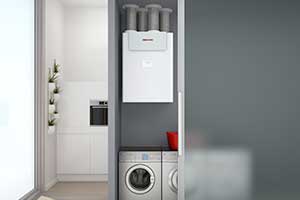Innovations in building materials and processes have benefitted consumers and housebuilders across the UK says Stiebel Eltron. Developments in insulation and weather stripping have led to a marked and welcome improvement in the hermetic integrity and heat retention capabilities of the modern home.
These improvements do, however, provide a challenge for those in the heating and ventilation sector. On one hand, it has exponentially increased the popularity of ventilation systems, which is a fantastic positive for the industry. On the other, it presents a challenge with regards to effectively ventilating these new, increasingly airtight developments.
The latest UK building regulations demand there is at least one air change every two hours in a residential development; a key target new ventilation and heat recovery systems must meet. By developing and innovating, manufacturers must attain this standard without compromising on housing design, or creating unwieldy space-hungry units.
The latest industry innovations, including the recently launched Stiebel Eltron LWZ series, provide a new breed of ground-breaking ventilation systems that incorporate these benefits while also offering unique opportunities for efficient heat recovery.
Through integrated heat recovery, modern ventilation systems tackle the air movement challenges of modern homes while improving air quality throughout a residence, and providing unprecedented customisation.
This allows homeowners to tailor environmental conditions to their own personal requirements, with some models also providing moisture recovery, which further enhances this bespoke climate control.
Homes are also becoming smaller, and space-saving housing design alongside simplified installation processes are key to creating viable ventilation systems. Breakthroughs in technology, including low profile LVE ducting, means these systems can minimise the space they require within a development.
This is vital, along with a unit that operates below the recommended decibel limits for residential areas, to ensuring that disruption is kept to a minimum for homeowners.
The LWZ series is also listed on the SAP Product Characteristic Database, assisting the installation and design process with accurate modelling statistics that provide insights into the carbon dioxide savings it provides. This information ensures installers and specifiers are well-equipped to choose the correct unit for any given development.
Residential developments are not the only projects that can benefit from the heat recovery capabilities of a ventilation system integrated with heat pumps. Small commercial units can benefit from the improvements in heat exchanger technology these units use, with the opportunity to recover 90% of the thermal energy in extract air, placing them at an A rating on the EU ErP energy standards.
There is a considerable push for the UK to improve on housebuilding targets as we move into 2018, and new developments are under increasing scrutiny to achieve high ratings in the EU’s ErP energy standards. Therefore, integrating ventilation units with heat recovery and heat pump systems could provide a viable route to achieving targets without sacrificing on space or usability.




Add new comment